#organic fertiliser
Explore tagged Tumblr posts
Text
How to Use Fulvic Acid, Seaweed Tonic, and Rock Dust to Grow Amazing Plants
Every gardener dreams of lush, vibrant plants that flourish in their garden. While proper care and maintenance are essential, there are some secret ingredients that can take your gardening skills to the next level. In this blog post, we'll explore three natural wonders - Fulvic Acid, Seaweed Tonic, and Rock Dust - and learn how to use them effectively to grow amazing plants. These organic additives can significantly enhance the health and productivity of your garden, providing you with bountiful harvests and stunning ornamentals. Read more…
#liquidhumateconcentrate#calciumplusforplants#aminoacidfertiliser#organic fertiliser#soil fertilisers#rock dust
2 notes
·
View notes
Text
Comparing Organic and Chemical Fertiliser Emissions in Australian Agriculture
Australia is still figuring out how to farm in a way that lasts. The big question is whether to use organic or chemical fertilisers. Both types help grow more food and keep people fed. But they affect the environment when it comes to gases that warm up the planet. Let’s look at how much of these gases organic and chemical fertilisers give off in Australian farming. Understanding Fertiliser…
0 notes
Text
0 notes
Text
Resolutely not reblogging a post about the UK biodiversity crisis to point out that drastic declines in biodiversity in the last 20-100 years do not, necessarily, mean that the entire history of human cultivation of nature here is catastrophic. Like, I get the point the person was making and I also think that the 'we made this green and pleasant land' rhetoric is usually thinly-veiled nationalist chauvinism, but also please think about the statistics you're using.
If your stats all point to the major damage being in the last century or two, this relates to industrialisation, industrial farming, power consolidation, and un/deregulation, not the activities of ordinary farmers 500 years ago or whatever. Therefore, it's not actually countering the points the 'green and pleasant land' chuds are talking about.
#a huge part of our current biodiversity crisis is in fact the fact that we *don't* use the land like we used to#we invested in industry artificial fertiliser and nimbyism instead#and like yes those were organic products of our history#but the strand of history that will be most instructive is the history of power and power relations#most people here for most of history/prehistory existed in a reasonable equilibrium with the natural world#were we ecosystem engineers on the level of the indigenous people of the americas? absolutely not#but that's a fairly high bar to clear they were/are extremely good at it
10 notes
·
View notes
Text
fighting for my life on reddit talking about parthenogenesis and sequential hermaphroditism
#Emu tries to post#good god#someone has come into the conversation saying#HEY THATS NOT TRUE INTERSEX FISH CAN REPRODUCE ASEXUALLY#my sudden acquaintance . That word does not mean what you think it means#I was saying that I've never heard a case of an intersex fish/aquatic invert yet#and that anyway no intersex individual would be able to reproduce with both sets of organs#because someone brought it up (about betta fish reproducing asexually?) and I had to explain what it actually means#and now I have to explain to this guy that intersex and hermaphrodite are two very different things and you have gotten them badly mixed ip#also fighting for my life when people try to tell me ramshorns reproduce with self fertilisation#THEY DONT.#somehow I'm becoming a semi expert on the topic of snail reproduction#and because people get confused I also have to know about sequential hermaphroditism#which at least there is no aquatic snail doing that#idk what land snails do#everyone is always like: all snails are one sex and reproduce asexually!!1!111#nooooooo#even the few species of aquatic hermaphrodite still mostly need partners#only 2 species actually reproduce asexually. And one of them is gonochoric#well technically parthenogenesis doesn't count as asexual apparently??#but for the purposes of me talking about which snails reproduce without sex they do count
6 notes
·
View notes
Text
Diatomaceous Earth Australia: Unleash Nature’s Power for Sustainable Solutions.
In an era where environmental responsibility and sustainable practices are at the forefront of agriculture and industry, innovative natural products are gaining traction. Diatomaceous Earth Australia is one such solution, offering a silica-rich, naturally occurring powder derived from fossilized diatoms. This eco-friendly mineral is celebrated for its effectiveness in natural pest control, soil enhancement, and water filtration. Alongside this, many growers and environmental enthusiasts are turning to Organic Liquid Fertiliser to provide their plants with nutrient-rich, chemical-free nourishment.

Harnessing Nature’s Strength
Diatomaceous Earth Australia serves multiple purposes in sustainable agriculture. Its fine, porous structure not only aids in pest management by mechanically damaging insect exoskeletons but also improves soil aeration and water retention. When paired with Organic Liquid Fertiliser, which offers readily available nutrients and supports healthy plant growth, these natural products create a synergistic effect. The combination of pest control and nutrient enrichment helps farmers reduce reliance on synthetic chemicals and promotes robust, organic farming practices.
Benefits of Natural Solutions
Both Diatomaceous Earth Australia and Organic Liquid Fertiliser have distinct advantages that contribute to sustainable development:
Eco-Friendly: Both products are derived from natural sources and are free from harmful chemicals.
Versatility: They can be used across various agricultural, gardening, and industrial applications.
Improved Soil Health: Diatomaceous earth enhances soil structure, while organic liquid fertiliser boosts plant growth with balanced nutrients.
Cost-Effective: Over time, these products reduce the need for expensive, synthetic alternatives and help create healthier ecosystems.
Testimonials
Real-world success stories reinforce the impact of these natural products on sustainable agriculture:
"Using Diatomaceous Earth Australia in our fields has noticeably reduced pest infestations while improving soil quality. Combined with Organic Liquid Fertiliser, our crops are healthier and more resilient." — Sarah D., Organic Farmer
"The shift to natural solutions has been a game-changer for our garden. Diatomaceous Earth Australia helped control pests without chemicals, and Organic Liquid Fertiliser boosted our plant growth significantly." — Michael T., Home Gardener
These testimonials underscore the positive impact of integrating natural products into everyday agricultural practices.

Frequently Asked Questions (FAQ)
Q: What is Diatomaceous Earth Australia? A: Diatomaceous Earth Australia is a naturally occurring, silica-rich powder derived from fossilized diatoms. It is used for natural pest control, soil improvement, and water filtration.
Q: How does Organic Liquid Fertiliser benefit plants? A: Organic Liquid Fertiliser provides essential nutrients in an easily absorbed form, promoting healthy growth, increased yield, and improved soil microbial activity.
Q: Can these products be used together? A: Yes, when used in tandem, Diatomaceous Earth Australia and Organic Liquid Fertiliser offer complementary benefits that enhance soil health and plant growth while reducing reliance on synthetic chemicals.
Q: Are these products safe for the environment? A: Absolutely. Both products are eco-friendly and support sustainable practices, making them safe alternatives to chemical-based solutions.
Conclusion
Diatomaceous Earth Australia and Organic Liquid Fertiliser are powerful natural solutions that enable sustainable agricultural practices. By leveraging the unique benefits of these eco-friendly products, farmers, gardeners, and industry professionals can create healthier, more productive ecosystems. With their proven effectiveness in pest control, soil enhancement, and plant nourishment, these products are paving the way for a greener future in agriculture and beyond. Embracing such natural solutions not only boosts productivity but also contributes to the long-term health of our environment.
0 notes
Text
Fertilizer Export from India: Opportunities and Insights

India, one of the world's largest agricultural economies, plays a significant role in the global fertilizer market. While the primary focus remains on domestic consumption, Indian fertilizer exports have seen steady growth over the years. With advancements in technology, evolving trade policies, and increasing global demand for agricultural inputs, India holds immense potential in the fertilizer export sector. This article provides an in-depth look at India's fertilizer production, key export destinations, leading fertilizer exporters, and the overall profitability of fertilizer exports.
Fertilizer Production in India: An Overview
India produced approximately 21.99 million metric tonnes (MT) of fertilizers in the fiscal year 2023–2024, measured in terms of the essential nutrients nitrogen (N) and phosphate (P2O5). This marks a 6% increase from the previous year. Among specific fertilizers, urea production surged by 10.2%, reaching 31.41 million MT, while NP/NPK complex fertilizer production rose by 2.7% to 9.55 million MT. The Indian fertilizer industry was valued at USD 41.2 billion in 2023 and is projected to grow at a compound annual growth rate (CAGR) of 6.1%, reaching USD 70.2 billion by 2032.
India's Fertilizer Export Data: 2023-2024
India’s fertilizer exports experienced fluctuations, with total exports falling from USD 130.43 million in 2022-23 to USD 37.58 million in 2023-24, based on fertilizer export data. Between March 2023 and February 2024, India exported 2,334 shipments to 771 buyers, facilitated by 501 fertilizer exporters. Over the past decades, India’s fertilizer exports have varied significantly, reaching an all-time high of USD 130.43 million in 2022 and a record low of USD 2.56 million in 1999.
A major reason for the recent decline in fertilizer exports is China’s decision to restrict its fertilizer exports, leading to global shortages. Consequently, India prioritized domestic supply to ensure sufficient availability of crucial fertilizers such as urea and DAP for its farmers.
Key Fertilizer HS Codes for Export
Harmonized System (HS) codes are crucial in streamlining the fertilizer export process. Some key fertilizer HS codes include:
3101: Fertilizers derived from vegetable or animal sources
3102: Nitrogen-based chemical or mineral fertilizers
3104: Potassium-based chemical or mineral fertilizers
3105: Fertilizers containing a mix of nitrogen, phosphorus, and potassium
These HS codes help exporters classify their products accurately and ensure smooth trade operations.
Top Destinations for India's Fertilizer Exports
India exports fertilizers to over 50 countries, with the top 15 destinations accounting for 80% of total exports. Major importers of Indian fertilizers include:
Nepal – USD 2.64 million
United States – USD 2.60 million
Philippines – USD 1.34 million
Kenya – USD 944k
Bangladesh – USD 928k
China – USD 776k
Sri Lanka – USD 694k
Vietnam – USD 597k
Tanzania – USD 478k
Indonesia – USD 314k
The consistent demand from these countries highlights India's strong position in the global fertilizer market.
Global Fertilizer Export Market: Leading Exporters
The global fertilizer market is highly competitive, with several key players dominating exports. The top fertilizer exporting countries include:
Russia – USD 15.24 billion
China – USD 9.71 billion
Canada – USD 9.55 billion
United States – USD 5.48 billion
Morocco – USD 5.46 billion
Saudi Arabia – USD 4.36 billion
Belgium – USD 2.78 billion
Netherlands – USD 2.59 billion
Oman – USD 2.58 billion
Egypt – USD 2.46 billion
Among these, Russia leads the global fertilizer export market with a value of USD 15.24 billion. The increasing demand for fertilizers worldwide presents a significant opportunity for Indian exporters to expand their market reach.
Leading Fertilizer Exporters in India
Several prominent Indian companies contribute significantly to the country’s fertilizer exports. Some of the top fertilizer exporters in india include:
Agile India Exports
Vani International Trade LLP
Joshi Agrochem
Gujarat State Fertilizers & Chemicals Ltd
Chambal Fertilisers
Coromandel International Limited
Deepak Fertilisers and Petrochemicals Co. Ltd.
Go Green Agri Solutions
Nagarjuna Fertilizers and Chemicals Ltd
Rama Phosphates Limited
These companies play a pivotal role in supplying quality fertilizers to international markets.
Is Fertilizer Export From India Profitable?
Fertilizer export from India can be highly lucrative when managed effectively. Exporters need to balance global demand, trade policies, and economic conditions to maximize profitability. Identifying niche markets and focusing on specific fertilizer categories can further enhance business opportunities. Sustainable practices and innovation in fertilizer production can also provide a competitive edge in the market.
How Can Eximpedia Assist Fertilizer Exporters?
Eximpedia.app serves as a valuable platform for Indian fertilizer exporters seeking global buyers. The platform provides authentic export data, including:
Verified lists of international fertilizer buyers
Competitive pricing insights
Comprehensive details on HS codes
Market trends and analysis
By leveraging Eximpedia’s resources, exporters can make informed decisions and expand their global reach effectively.
Final Thoughts
The fertilizer export business in India holds substantial growth potential. Staying updated on market trends, competitor strategies, and trade policies is crucial for success. Since navigating international markets can be complex, platforms like Eximpedia.app provide essential data and insights to support exporters. Whether you are an existing exporter or planning to enter the fertilizer export market, accessing reliable export data can significantly enhance your business prospects.
For a deeper understanding of India's fertilizer export data, including shipment details, leading exporters, and HS codes, visit Eximpedia.app today and take your fertilizer export business to new heights.
#fertilizer export from india#fertilizer exporters in india#fertilizer export data#organic fertilizer export from india#biggest exporter of fertilizer#fertiliser exports
0 notes
Text
How Farmers in Kenya Are Boosting Yields with Rabbit Urine
Farmers in Kenya are increasingly turning to rabbit urine as a natural alternative to synthetic fertilisers. They are finding it to be a healthier and more sustainable way to improve soil fertility and boost crop yields. Benedicta Nkirote, a farmer from Marurui in Meru county, swears by rabbit urine as an effective foliar fertiliser. Unlike conventional chemical fertilisers, rabbit urine…
#affordable fertiliser#Agricultural Innovation#Agroecology#chemical-free farming#Climate-Smart Agriculture#crop yield improvement#eco-friendly fertiliser#farm productivity#foliar fertiliser#insecticide alternative#kenyan farmers#macronutrients for plants#natural fertiliser#natural soil conditioner#organic farming kenya#organic manure#organic vegetable farming#permaculture Kenya#pest control#rabbit farming#rabbit urine benefits#rabbit urine fertiliser#SOIL FERTILITY#sustainable agriculture#sustainable pest management#synthetic fertiliser alternative
0 notes
Text
Improve Soil Health with Swift Grow | Organic Plant Booste

Nourish your garden with Swift Grow organic fertilizer! Rich in nutrients, it enhances plant growth, restores soil health & boosts yield. Perfect for sustainable gardening. https://swiftgrow.com.au/
#garden fertilizer#organic fertilizer for lawn#organic liquid fertilizer#soil fertiliser#bunnings organic fertiliser#bunnings fertiliser#liquid fertilizer for plants#organic fertilizer for plants#fertilizer for plants#best organic fertilizer for vegetables#quick grow fertilizer#best organic fertilizer#grass fertilizer spray#non toxic lawn fertilizer#fertilizer for sale#shop fertilizer#natural fertilizer for plants#best fertilizer for flowering plants#river stone fish farm#lawn fertiliser online
0 notes
Text
The Best News of Last Year - 2023 Edition
Welcome to our special edition newsletter recapping the best news from the past year. I've picked one highlight from each month to give you a snapshot of 2023. No frills, just straightforward news that mattered. Let's relive the good stuff that made our year shine.
January - London: Girl with incurable cancer recovers after pioneering treatment

A girl’s incurable cancer has been cleared from her body after what scientists have described as the most sophisticated cell engineering to date.
2. February - Utah legislature unanimously passes ban on LGBTQ conversion therapy

The Utah State Legislature has unanimously approved a bill that enshrines into law a ban on LGBTQ conversion therapy.
3. March - First vaccine for honeybees could save billions

The United States Department of Agriculture (USDA) has approved the world’s first-ever vaccine intended to address the global decline of honeybees. It will help protect honeybees from American foulbrood, a contagious bacterial disease which can destroy entire colonies.
4. April - Fungi discovered that can eat plastic in just 140 days
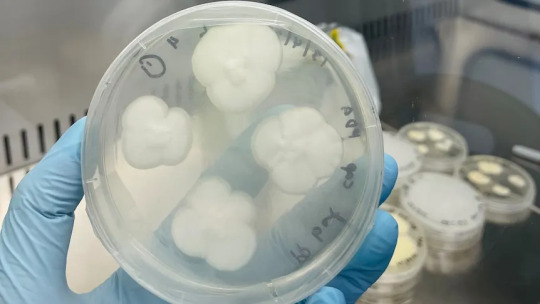
Australian scientists have successfully used backyard mould to break down one of the world's most stubborn plastics — a discovery they hope could ease the burden of the global recycling crisis within years.
5. May - Ocean Cleanup removes 200,000th kilogram of plastic from the Pacific Ocean

The Dutch offshore restoration project, Ocean Cleanup, says it has reached a milestone. The organization's plastic catching efforts have now fished more than 200,000 kilograms of plastic out of the Pacific Ocean, Ocean Cleanup said on Twitter.
6. June - U.S. judge blocks Florida ban on care for trans minors in narrow ruling, says ‘gender identity is real’

A federal judge temporarily blocked portions of a new Florida law that bans transgender minors from receiving puberty blockers, ruling Tuesday that the state has no rational basis for denying patients treatment.
7. July - World’s largest Phosphate deposit discovered in Norway

A massive underground deposit of high-grade phosphate rock in Norway, pitched as the world’s largest, is big enough to satisfy world demand for fertilisers, solar panels and electric car batteries over the next 50 years, according to the company exploiting the resource.
8. August - Successful room temperature ambient-pressure magnetic levitation of LK-99
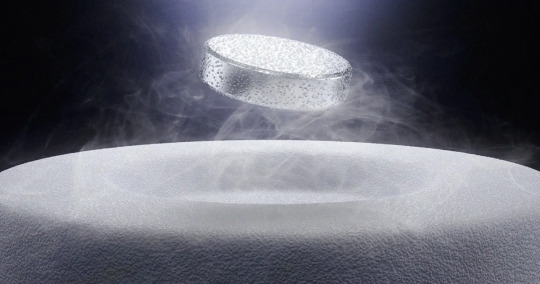
If the claim by Sukbae Lee and Ji-Hoon Kim of South Korea’s Quantum Energy Research Centre holds up, the material could usher in all sorts of technological marvels, such as levitating vehicles and perfectly efficient electrical grids.
9. September - World’s 1st drug to regrow teeth enters clinical trials

The ability to regrow your own teeth could be just around the corner. A team of scientists, led by a Japanese pharmaceutical startup, are getting set to start human trials on a new drug that has successfully grown new teeth in animal test subjects.
10. October - Nobel Prize goes to scientists behind mRNA Covid vaccines

The Nobel Prize in Physiology or Medicine has been awarded to a pair of scientists who developed the technology that led to the mRNA Covid vaccines. Professors Katalin Kariko and Drew Weissman will share the prize.
11. November - No cases of cancer caused by HPV in Norwegian 25-year olds, the first cohort to be mass vaccinated for HPV.
Last year there were zero cases of cervical cancer in the group that was vaccinated in 2009 against the HPV virus, which can cause the cancer in women.
12. December - President Biden announces he’s pardoning all convictions of federal marijuana possession
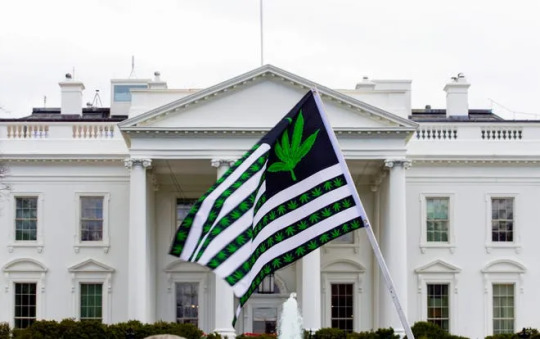
President Joe Biden announced Friday he's issuing a federal pardon to every American who has used marijuana in the past, including those who were never arrested or prosecuted.
------
And there you have it – a year's worth of uplifting news! I hope these positive stories brought a bit of joy to your inbox. As I wrap up this special edition, I want to thank all my supporters!
Buy me a coffee ❤️
Merry Christmas and Happy New Year!
6K notes
·
View notes
Text
Premium Organic Fertilisers in NZ

Are you in search of top-quality organic fertilisers in New Zealand? Look no further! At RD2, we are your trusted source for premium organic mineral fertilisers that will nourish your soil and promote healthy, thriving plants. Our commitment to sustainability and eco-friendly farming practices sets us apart in the industry. Whether you're a passionate gardener or a professional farmer, our range of organic fertilisers in NZ is designed to enhance soil fertility, improve crop yield, and promote the overall health of your plants.
For inquiries or to place an order, don't hesitate to reach out to us at 09 372 9155 or drop us an email at [email protected]. Our dedicated team is always ready to assist you in selecting the right organic fertilisers and plant nutritional products for your specific needs. Experience the benefits of organic farming and gardening with RD2, your partner in distributing top-tier organic fertilisers across New Zealand.
0 notes
Text
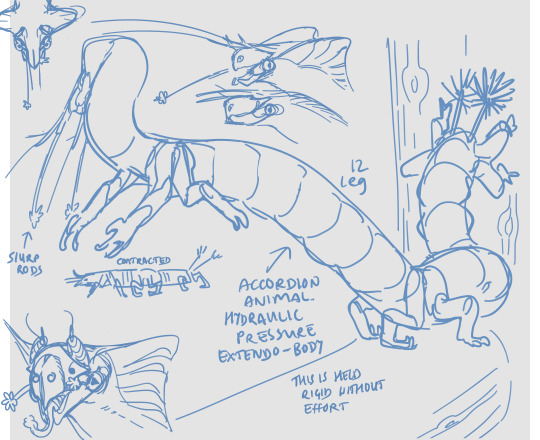
slinky animal drawing as promised (from the alien poll, arboreal was the winning option)
i don't like the face completely phoned it in while also spending like 3 hours just going through several iterations of this head design until it was sort of ok to me but it still looks derivative so just ignore that part anyway i'm more happy about the body which i drew in 0.5 seconds and was immediately satisfied with
the body has two slinky abdomens linked by a central pelvic girdle with four legs. both slinky zones can expand and contract by hydraulic action (instead of muscular extension) in an internal organ which is shaped like a double helix. When expanded, it can be up to 4x longer, and each section can expand independently. This is a slow-moving animal and it uses this ability to slowly bridge the gap between trees and branches. It's very strong and can support its entire body extending out on just one set of legs
it has a pair of feelers which are tipped by a sticky pom pom and these shoot out to ensnare prey. The structures at the back of the body that resemble dandelion seeds are in fact a pair of reproductive structures which, when fully developed, break off and fly away, again like dandelion seeds. the other end has a sticky substance that develops over the space of a few hours to ensure that there's decent flight time to disperse them before they glue themselves to the first surface they touch. then they're encountered by another member of the species who fertilises them, breaks off the feathery bits, and carries around the rest of the structure in one of their front arms until it hatches into a bunch of young which then ride around on the parent's back.
they are found inland on the western continent of siren
#surprise it was siren all along#originally i wanted a sapient tree guy but i liked the idea of it being a lil animal the size of your arm#you can keep one as a pet#setting: siren
193 notes
·
View notes
Text
#good news#environmentalism#science#environment#bugs#insects#animals#nature#fertilizers#compost#organic waste
145 notes
·
View notes
Text
"When Francois Beyers first pitched the concept of 3D ocean farming to the Welsh regulators, he had to sketch it on napkins.
Today the seafood farm is much more than a drawing, but if you walked along the Welsh coastal path near St David’s, all you’d see is a line of buoys. As Beyers puts it: “It’s what’s below that’s important.”
Thick tussles of lustrous seaweed suspend from the buoys, mussels cling to its furry connective ropes and dangling Chinese lantern-esque nets are filled with oysters and scallops.
“It’s like an underwater garden,” says Beyers, co-founder of the community-owned regenerative ocean farm, Câr-y-Môr. The 3-hectare site is part of a fledgling sector, one of 12 farms in the UK, which key players believe could boost ocean biodiversity, produce sustainable agricultural fertiliser and provide year-round employment in areas that have traditionally been dependent on tourism.
Created in 2020 by Beyers and six family members, including his father-in-law – an ex-shellfish farmer – the motivation is apparent in the name, which is Welsh for “for the love of the sea”. ...
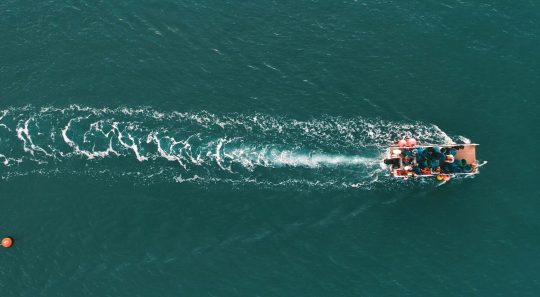
Pictured: Drone shot of Câr-y-Môr, which is on the site of abandoned mussel farms. Image: Scott Chalmers
Ocean farming comes from the technical term ‘integrated multi-trophic aquaculture’, which means a mixture of different seaweed and shellfish species growing together to mutually benefit each other. But it’s not just a way of growing food with little human input, it also creates ocean habitat.
“You’re creating a breeding ground for marine animals,” explains Beyers who adds that the site has seen more gannets diving, porpoises and seals – to name a few – since before the farm was established.
Ocean farms like Câr-y-Môr, notes Ross Brown – environmental research fellow at the University of Exeter – have substantial conservation benefits.
“Setting up a seaweed farm creates an exclusion zone so fishermen can’t trawl it,” explains Brown, who has been conducting experiments on the impacts of seaweed and shellfish farms across the UK.
Brown believes a thriving ocean farming industry could provide solutions to the UK’s fish stock, which is in “a deeply troubling state” according to a report that found half of the key populations to be overfished. “It would create stepping stones where we have safe havens for fish and other organisms,” he adds.
But UK regulators have adopted a cautious approach, note Brown and Beyers, making it difficult for businesses like Câr-y-Môr to obtain licenses. “It’s been a tough old slog,” says Beyers, whose aim is to change the legislation to make it easier for others to start ocean farms.
Despite navigating uncharted territories, the business now has 14 full-time employees, and 300 community members, of which nearly 100 have invested in the community-benefit society. For member and funding manager Tracey Gilbert-Falconer, the model brings expertise but most importantly, buy-in from the tight-knit local community.
“You need to work with the community than forcing yourself in,” she observes.
And Câr-y-Môr is poised to double its workforce in 2024 thanks to a Defra grant of £1.1 million to promote and develop the Welsh seafood industry as part of the UK Seafood Fund Infrastructure Scheme. This will go towards building a processing hub, set to be operational in April, to produce agricultural fertiliser from seaweed.
Full of mineral nutrients and phosphorous from the ocean, seaweed use in farming is nothing new, as Gilbert-Falconer notes: “Farmers in Pembrokeshire talk about their grandad going down to the sea and throwing [seaweed] on their farms.”
But as the war in Ukraine has caused the price of chemical fertiliser to soar, and the sector tries to reduce its environmental impact – of which synthetic fertiliser contributes 5% of total UK emissions – farmers and government are increasingly looking to seaweed.
The new hub will have capacity to make 65,000 litres of sustainable fertiliser annually with the potential to cover 13,000 acres of farmland.
But to feed the processing hub, generate profit and reduce their dependency on grants, the co-op needs to increase the ocean farm size from three to 13 hectares. If they obtain licences, Beyers says they should break even in 18 months.
For now, Beyers reflects on a “humbling” three years but revels in the potential uses of seaweed, from construction material to clothing.
“I haven’t seen the limit yet,” he smiles."
-via Positive.News, February 19, 2024
#wales#welsh#ocean#marine biology#aquaculture#marine life#marine animals#seaweed#sea scallops#oysters#united kingdom#uk#conservation#conservation news#overfishing#environmental news#farming#sustainable agriculture#sustainability#ocean farming#good news#hope
490 notes
·
View notes
Text
Diatomaceous Earth Food Grade Australia and Organic Liquid Fertiliser: Natural Solutions for Healthier Living.
In today’s world, many people are seeking natural and sustainable solutions for their everyday needs. Whether it’s for pest control, personal health, or enhancing the quality of soil for gardening, Diatomaceous Earth Food Grade Australia and Organic Liquid Fertiliser are two remarkable options that can help. Both are safe, effective, and environmentally friendly choices for those who want to live more naturally.

What is Diatomaceous Earth Food Grade Australia?
Diatomaceous Earth (DE) is a naturally occurring substance made from the fossilized remains of microscopic algae known as diatoms. Food grade DE is safe for humans and pets, and it has numerous uses around the home and garden. In Australia, Diatomaceous Earth Food Grade is becoming increasingly popular due to its versatility and effectiveness.
Benefits of Diatomaceous Earth Food Grade:
Pest Control: DE is a powerful, non-toxic pest control solution. When insects like ants, fleas, and cockroaches come into contact with DE, it scratches their exoskeletons and dehydrates them. It is an excellent choice for those who wish to avoid harmful chemicals in their homes.
Digestive Health: When ingested, food-grade DE can help support the digestive system by removing harmful toxins and waste from the intestines. Many people use it as a natural detox supplement.
Skin and Hair Health: DE contains high levels of silica, which is essential for healthy skin, hair, and nails. Many people use DE in skin care routines or as a supplement for better hair growth.
Natural Cleaning: With its fine, absorbent texture, Diatomaceous Earth is perfect for soaking up spills and odors. It’s a must-have for any natural cleaning regimen.
Organic Liquid Fertiliser: A Better Choice for Your Garden
Another great option for those who are interested in living more sustainably is Organic Liquid Fertiliser. Unlike chemical fertilizers, which can harm the environment and soil quality, organic liquid fertilisers are made from natural sources and provide a rich mix of nutrients for plants.
Benefits of Organic Liquid Fertiliser:
Improved Soil Health: Organic fertilisers enrich the soil with essential nutrients and beneficial microorganisms that improve the structure and health of the soil. They help to restore and maintain the balance of nutrients, ensuring your garden thrives.
Better Plant Growth: Plants fed with organic fertiliser grow healthier and stronger, thanks to the presence of vital nutrients like nitrogen, phosphorus, and potassium. Organic liquid fertiliser promotes lush foliage, vibrant flowers, and better fruit production.
Environmentally Friendly: Organic liquid fertilisers are free from harmful chemicals and toxins, making them safe for the environment, pets, and people. They do not pollute waterways or harm beneficial insects and wildlife.
Sustainable Gardening: By using organic liquid fertiliser, you contribute to a more sustainable future. You reduce reliance on synthetic products, and you encourage biodiversity in your garden.
Why Choose Diatomaceous Earth and Organic Liquid Fertiliser?

When used together, Diatomaceous Earth and Organic Liquid Fertiliser create a powerful, natural solution for your home and garden. Diatomaceous Earth helps keep pests at bay, while organic liquid fertiliser nourishes the soil and promotes plant health. Both products are eco-friendly, safe to use, and effective, making them ideal choices for those looking to lead a more sustainable lifestyle.
If you're looking for high-quality Diatomaceous Earth Food Grade in Australia, you can reach out to +61407648916 or email [email protected] to place an order or ask for more information.
0 notes